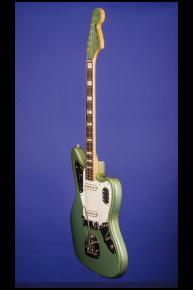"Blue Ice Metallic" Jaguar - One of the Rarest of all Fender Custom Colors
1966 Fender Jaguar
This incredibly rare "Blue Ice Metallic" Jaguar weighs just 8.70 lbs. and features a solid alder body, contoured on the bass side. One-piece maple neck with a nut width of just under 1 5/8 inches, a scale length of 24 inches and a wonderful medium profile. Bound veneer rosewood fretboard with 22 original medium/thin frets and inlaid pearl block position markers. Headstock with matching "Blue Ice Metallic" finish and decal with "Fender" logo in gold with black trim, "JAGUAR" in black in bold letters beside it, and four patent and one design number in black below it. With "Offset Contour Body" at the ball end of the headstock. Single "butterfly" string tree with nylon spacer. Individual Fender "F" Tuners with octagonal metal buttons.
"F-Series" neckplate with the serial number "178526" stamped between the top two screws. The end of the neck is stamped "15 OCT 66B". Two white oblong Strat-like pickups with notched metal side plates and balanced outputs of 5.91k and 5.94k. Three-layer, white over black plastic pickguard with ten screws. Two controls (one volume, one tone) and jack socket on lower metal plate adjoining pickguard on treble side, selector switch and two roller controls (one volume, one tone) on upper metal plate adjoining pickguard on bass side, and three slide switches on metal plate inset into the pickguard on the treble side. Black plastic Jaguar knobs. The pots are dated: "137 6634" (CTS August 1966). Jazzmaster-type floating tremolo and bridge with adjustable mute. A truly spectacular example in totally original condition with just a small amount of belt buckle rash on the back, and a few small surface chips on the sides. The Ice Blue Metallic finish has slightly and uniformly faded (including the headstock) to a wonderful teal green and is really the the most attractive example we have ever seen. Some very light playing wear to the varnish on the sides of the neck affecting the first three frets only. Some light wear to the original frets, but with no divots to the fretboard. Complete with the original tremolo arm and bridge cover. Also included is the original black leather guitar strap, original guitar cord, original twelve-page hang tag/instruction manual with matching serial number, original "Tolex" case hang-tag, original eight-page Fender Fine Electric Instruments price list dated July 1966 (showing the original price of $386 + $52.50 for the case) and an original Fender "B" string in its plastic wallet with the bridge adjustment allen key. Housed in its original Fender three-latch rectangular black hardshell case with dark orange plush lining (9.00). This is the color that will be missing from most collections…
In late 1965 a white binding was added to the neck, but it was not until mid 1966 that the favored "dot" inlays were replaced by the "later-style" rectangular "pearl-block" markers.
Automobiles in the United States had more social influence than just about anything in the fifties and sixties and the vast array of colors that Fender used on their guitars during that period originated directly from the cars of the time. Blue Ice Metallic is a Lucite (acrylic) paint that was introduced in 1965 by the Ford Motor Company and used on their cars for just one year until 1966. Fender followed suit and used it very sparingly on Jaguars, Jazzmasters, Stratocasters and Telecasters between 1965 and 1969. Blue Ice Metallic is now one of the rarest and most sought after of all the Fender "custom colors".
"Not content with the relatively expensive Jazzmaster, Fender introduced a new top-of-the-line model in 1962: the Jaguar. [The pricelist offered a basic Sunburst Jaguar at $379.50; a similar Jazzmaster was $349.50]. Another offset-waist multi-control instrument, the Jag seemed an attractive proposition, but still failed to dent the supremacy of Fender's dynamic duo, the Tele and the Strat...The Jag used a similar offset-waist body shape to the earlier Jazzmaster, and also shared that guitar's separate bridge and vibrato unit, although the Jaguar had the addition of a spring-loaded string mute at the bridge. Fender rather optimistically believed that players would prefer a mechanical string mute to the natural edge-of-the-hand method. They did not. There were some notable differences between the Jaguar and Jazzmaster. Visually, the Jag had distinctive chromed control panels, and was the first Fender with 22 frets. Its 24" (610mm) scale-length ('faster, more comfortable') was shorter than the Fender standard of 25" (635mm) and closer to that of Gibson. It gave the Jag a different playing feel compared to other Fenders. The Jaguar had better pickups than the Jazzmaster. They looked much like Strat units but had metal shielding added at the base and sides, no doubt as a response to the criticisms of the Jazzmaster's tendency to noisiness. The Jag's electrics were yet more complex than the Jazzmaster's, using the same rhythm circuit but adding a trio of lead-circuit switches...The Jaguar was offered from the start in four different neck widths, one a size narrower and two wider than normal (coded A, B, C or D, from narrowest to widest, with 'normal' B the most common)" (Tony Bacon, 50 Years of Fender, p. 36).











